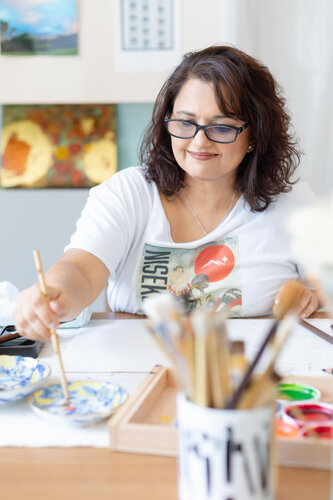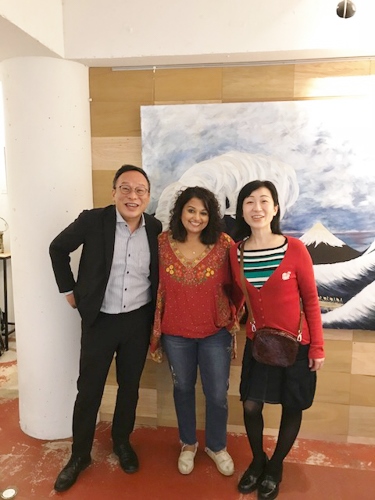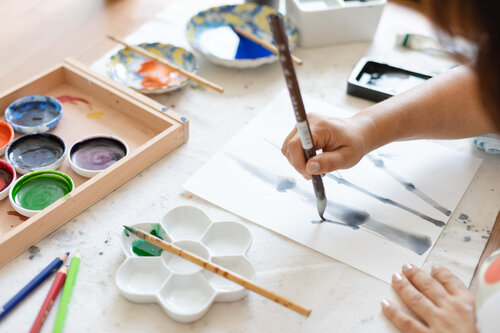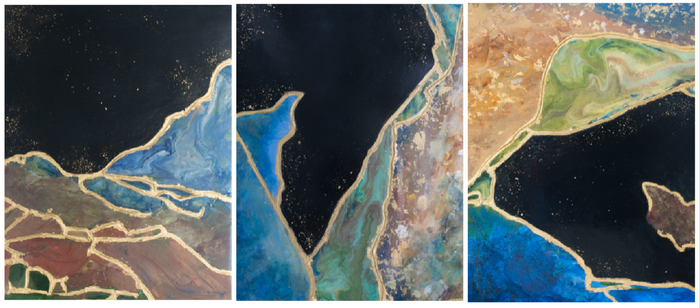Traveling and living internationally has dramatically influenced artist Rajul Shah’s aesthetic, technique and potential markets. She shares what she has learned as an expat.

Artist Rajul Shah in her studio
I am an Indian-American artist whose career was formed in a country not of my nationality, nor of my birth. Outside a brief time (less than two years) spent in India, most of my formative years were balanced between the Western influences of America and the cultural foundations of India.
I began my journey as an expatriate artist when my husband’s career brought our family to Japan. At that time, I retired from my first career in healthcare to pursue my passion in art. I’ve benefitted from a Japanese style of teaching – repetitive technique training and copying the masters. After studying photography, art history, drawing and painting, I fell in love with painting. Since then I have focused extensively across oil and acrylics, and Sumi-E/Nihonga.
My first group show was in 2016, with a solo show in 2017 and a national juried group exhibition in 2018 at the National Art Center in Tokyo. I had the honor of two more national juried exhibitions in 2019 at the Tokyo Metropolitan Museum of Art and the Ueno No Mori Museum. In Japan, venues for foreign emerging artists can be difficult to find, especially when you don’t speak the language. However, when you do find them and if you attempt to communicate sufficiently in Japanese, the community is welcoming.

Shah at her solo show for The Fuji Collection at the Kitano Alley Gallery in Kobe, Japan
My husband’s career brought us to Singapore in 2019. I found that learning the dynamics of the art scene and establishing myself in a new city and country can be a daunting task. It takes time to explore, research art organizations, network and meet other artists. Singapore has a strong focus on enabling local artists, while opportunities for foreign emerging artists are limited. Because I am an artist with clients in other areas of the world, my approach to the market involves acting as an international businessperson and focusing on social media strategy.
A Pause for Reflection
The COVID pandemic posed a challenge to my ability to network and become involved in local group projects. Still, like most of my artist-colleagues across the world, I used the quiet time to evaluate my business strategies and harness creative energies in the studio. I reflected on my artistic journey thus far in order to figure out my future direction.
Because I have lived across different cultures and traveled abroad, it has allowed me to experience vast amounts of learning, inspiration and reflection. I found this both creatively as an artist and professionally as a businessperson.
As artists we are told that we must strive for a signature style or an innovation in application of concepts that are unmistakably linked to us as individuals. Picasso, Monet and Kandinsky are held up as examples. I don’t know if I will ever achieve that level of uniqueness, or even if it’s a realistic expectation. I’m in a state of constant change and artistic evolution as I live, learn and travel through different lands and cultures.

Work in progress in artist Rajul Shah’s studio
I do know that I’m always inspired by new and different things. My Indian heritage was the inspiration for my first show. I transitioned to landscapes as I traveled across Asia and also focused on Mt. Fuji when I lived in Japan. On a conceptual level, I now find myself evolving abstractly into the area of art as a source of healing.
Influences
Living in Japan is an aesthetic pleasure. I experienced the culture of hospitality (omotenashi), and the philosophies of Zen, Minimalism, and Harmony (with nature and each other). All of these influences emanate into daily life. Japanese gardens are purposely designed to allow for peaceful reflection. Japanese architecture and design are known for the minimalistic use of structures to allow for the flow of energy through its space. This is a prime example of the Japanese concept of “Ma” (pronounced maah).
The Japanese art of Kintsugi is a physical manifestation of resilience. Its purpose is to repair. Instead of discarding a broken vessel, it is repaired with a golden adhesive that enhances the break lines, making the piece unique. The concept calls attention to the lines made by time and rough use; they aren’t a source of shame. The practice, also known as kintsukuroi, literally means gold mending. It emphasizes the beauty and utility of breaks and imperfections, and stems from philosophies of Mottanai (an expression of regret of waste) and Mushin (the need to accept change).

Kintsugi Earth I, II & III, Acrylic, Canvas & 23kt Gold Leaf on Wood, each 40 x 50cm, by Rajul Shah. The art of Kintsugi is used in a 2D expression of an Earth mended after climate change.
Art and Healing
My prior career in healthcare and Indian spiritual philosophies of the human chakras (energy centers) have shown me the close connection between emotional and physical well-being.
When I look at the world today, there is a collective need for healing. COVID, climate change, natural disasters, loss of job, human slavery and trafficking are all issues that humanity must deal with on a daily basis. On some level, we have all been broken or are recovering from something. This may be an illness, the loss of a loved one, personal trauma or otherwise. We all need “mending” in some way.
My latest series is focused on how we heal spiritually and environmentally. Inspired by the art of Kintsugi, the Kintsugi series is a 2D depiction of an Earth mended after climate change. It encapsulates the hope that we can repair, heal, treasure and preserve our planet for our children.
In my Chakras series, internal energy centers are explored to reframe spirituality. These paintings translate the chakra’s essence into a reflective interpretation of the energy it contributes to well-being.
I am not sure what my next set of creations will look like. I expect it will represent a combination of the concepts I’ve mentioned as they relate to the need to fix what is broken and heal wounds.
Human beings are products of their internal and external environments. I don’t know where our careers will take us next in terms of a home country or city. What is known is that I will be traveling, learning and exploring cultures for a long while. Constant change can be tiring. But it’s also exciting when I consider the possibilities of where artistic evolution will take my work.


Thank you for this wonderful opportunity. I really enjoy Artsy Shark and reading about my artist-colleagues. The resources on this site are very helpful
Rajul, It is a pleasure to share your story and what you’ve learned from living in different countries around the world. In a world that grows smaller every day, many others will have similar experiences as well. It’s great to know that you can take advantage of opportunities no matter where you are!
Love seeing how you’ve become an artist!